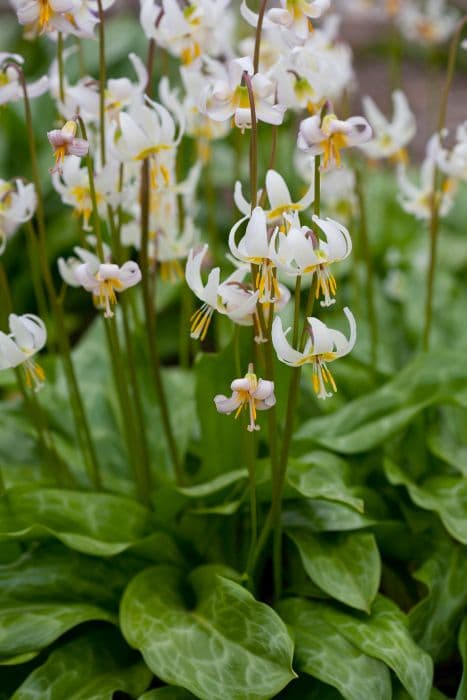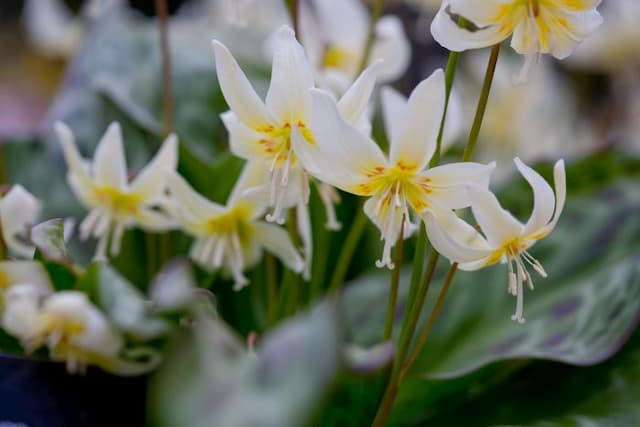Toad Lily Tricyrtis 'White Towers'

ABOUT
Tricyrtis 'White Towers', commonly known as toad lily, is a visually striking perennial recognized for its unique and ornate flowers. The plant features lush, green foliage that consists of lance-shaped leaves arranged alternately along the stems. These leaves are glossy and can have a slightly arching, or weeping, habit that contributes to the plant's overall aesthetic. The most notable feature of the toad lily, however, is its intricate flowers. Blooming in late summer to autumn, 'White Towers' sports star-shaped blossoms with a base color of creamy white. Often, these blooms are accented with delicate purple spots, which enhance their exotic look and texture. The flowers cluster at the stem's tips and along the upper leaf axils, creating charming, eye-catching displays amidst the foliage. Toad lilies are appreciated for their exotic beauty and their ability to flower in the shadier parts of a garden, offering a unique decorative touch. Each bloom, while relatively small, is complex and has a graceful, almost orchid-like appearance that draws attention. The contrasting color pattern of white and purple on the flowers adds depth and a touch of whimsy to the plant's presentation.
About this plant
 Names
NamesFamily
Liliaceae
Synonyms
Toad Lily, Toadlily
Common names
Tricyrtis 'White Towers'.
 Toxicity
ToxicityTo humans
Toad Lily (Tricyrtis 'White Towers') is not commonly known to be toxic to humans. There are no well-documented cases or reports indicating that Tricyrtis species are poisonous if ingested. However, it is generally advisable to avoid eating ornamental plants due to potential individual sensitivities or unknown toxicities. If concerned about plant ingestions or experiences of adverse reactions, it's best to consult medical professionals.
To pets
Toad Lily (Tricyrtis 'White Towers') is not commonly listed as toxic to pets, such as dogs and cats. However, the consumption of any plant material may cause vomiting and gastrointestinal upset in pets due to their sensitive digestive systems. It's best to discourage pets from eating plants and consult a veterinarian if your pet shows symptoms of distress after ingesting any part of a plant.
 Characteristics
CharacteristicsLife cycle
Perennials
Foliage type
Deciduous
Color of leaves
Green
Flower color
White
Height
2-3 feet (60-90 cm)
Spread
1-2 feet (30-60 cm)
Plant type
Herb
Hardiness zones
4-9
Native area
Asia
Benefits
 General Benefits
General Benefits- Aesthetic Appeal: Tricyrtis 'White Towers', also known as Toad Lily, has unique and attractive white blooms that provide visual interest in garden settings.
- Shade Tolerance: The Toad Lily thrives in shady areas where many other flowering plants might struggle, making it ideal for woodland gardens or shaded borders.
- Late-Season Blooms: It flowers in late summer to fall, offering color and beauty when many other plants have finished blooming.
- Wildlife Attraction: The flowers attract pollinators such as bees and butterflies, supporting local ecosystems.
- Low Maintenance: Once established, the Toad Lily is generally low maintenance, requiring minimal care beyond occasional watering and mulching.
- Drought Resistance: Although it prefers moist conditions, the Toad Lily can tolerate periods of drought once it is well established.
- Versatility: It can be used in a variety of garden designs, including perennial borders, container gardens, and underplanting for taller shrubs.
- Disease Resistance: It is relatively resistant to common garden pests and diseases, contributing to its ease of care.
 Medical Properties
Medical PropertiesThis plant is not used for medical purposes.
 Air-purifying Qualities
Air-purifying QualitiesThis plant is not specifically known for air purifying qualities.
 Other Uses
Other Uses- Shade Garden Texture: Tricyrtis 'White Towers', or toad lily, provides unique texture with its speckled blooms for shade gardens lacking in diversity.
- Photography Subject: The distinct flower patterns make toad lilies interesting subjects for macro photography enthusiasts.
- Artistic Inspiration: Artists may derive inspiration from the intricate designs of toad lily flowers for paintings, textile patterns, or other artistic creations.
- Culinary Garnish: Although not commonly eaten, toad lily flowers could be used as an ornate, non-toxic garnish for special culinary presentations.
- Educational Use: Toad lilies can be utilized in horticultural education to illustrate plant diversity and adaptation in shaded environments.
- Watercolor Painting: The delicate flowers of toad lilies are ideal subjects for watercolor artists practicing botanical illustrations.
- Children's Gardens: Toad lilies can be planted in children's gardens to foster curiosity with their unusual flowers.
- Fairy Gardens: Their unique appearance makes toad lilies suitable for incorporating into whimsical fairy garden designs.
- Theme Gardens: Toad lilies can be used in theme gardens, such as 'storybook' or 'fantasy' gardens, due to their exotic-looking flowers.
- Bee and Butterfly Attraction: While commonly not noted, toad lilies can attract pollinators such as bees and butterflies, adding to the biodiversity of the garden.
Interesting Facts
 Feng Shui
Feng ShuiThe Toad Lily is not used in Feng Shui practice.
 Zodiac Sign Compitability
Zodiac Sign CompitabilityThe Toad Lily is not used in astrology practice.
 Plant Symbolism
Plant Symbolism- Exotic Beauty: The Tricyrtis, commonly known as Toad Lily, has intricate and unique flowers that symbolize exotic beauty, representing something rare and strikingly beautiful that stands out from the familiar.
- Uniqueness: Each Toad Lily bloom has a unique pattern, symbolizing individuality and the distinctiveness of each person.
- Opportunities: The way Toad Lilies thrive in shady areas can symbolize the idea of finding opportunities in unexpected places or blooming where one is planted.
- Overcoming Challenges: Toad Lily's ability to grow in less than ideal conditions may represent resilience and the capability to overcome challenges and hardships.
- Purity: The 'White Towers' variety, with its bright white flowers, could be associated with purity, innocence, and clarity.
 Water
WaterFor the Toad Lily (Tricyrtis 'White Towers'), water deeply once a week, ensuring that the soil is moist but not waterlogged. During the growing season, you may need to water more frequently, especially if the weather is particularly hot or dry. Apply about 1 to 1.5 gallons of water to the base of the plant, avoiding overhead watering to reduce the risk of leaf diseases. In the fall and winter, reduce watering as the plant goes dormant. Always check the soil moisture level before watering to avoid overwatering.
 Light
LightThe Toad Lily thrives in partial to full shade, making it an ideal plant for shaded garden spots or woodland settings. It should be protected from the harsh afternoon sun, which can scorch its delicate leaves. The best spot for this plant is one where it receives dappled sunlight or light shade throughout the day.
 Temperature
TemperatureToad Lilies prefer cooler temperatures and perform well in a range between 50 to 75 degrees Fahrenheit. They can survive brief periods of temperatures just below freezing, but prolonged exposure to temperatures below 30 degrees Fahrenheit can be harmful. The ideal growing conditions would involve cool to moderate temperatures, avoiding extreme hot or cold.
 Pruning
PruningPrune the Toad Lily in late winter or early spring before new growth starts. Cut back any dead or damaged stems to maintain plant health and encourage bushier growth. Pruning is not needed for shaping, as this plant naturally forms an attractive shape. The best time for pruning is when the plant is dormant and the danger of frost has passed.
 Cleaning
CleaningAs needed
 Soil
SoilToad Lily 'White Towers' thrives in a soil mix that retains moisture yet drains well. A blend of peat moss, perlite, and pine bark suits it well with a pH between 5.5 and 7.0.
 Repotting
RepottingToad Lilies like 'White Towers' typically need repotting every 2 to 3 years or when the plant becomes root-bound.
 Humidity & Misting
Humidity & MistingToad Lily 'White Towers' prefers high humidity levels, ideally between 50% to 70%, to mimic its native woodland habitat.
 Suitable locations
Suitable locationsIndoor
Place Toad Lily 'White Towers' in well-lit area, away from direct sun, high humidity.
Outdoor
Plant Toad Lily 'White Towers' in shade and moist, well-draining soil.
Hardiness zone
4-9 USDA
 Life cycle
Life cycleThe life of the Tricyrtis 'White Towers', commonly known as Toad Lily, begins with seed germination, which occurs in a moist, well-drained soil environment. Following germination, the seedlings develop into juvenile plants, producing a rosette of leaves and establishing a strong root system. As the plant matures, it enters the vegetative growth stage, where it develops its characteristic foliage and stems, thriving in partial to full shade. Upon reaching maturity, the Toad Lily produces distinctive white flowers with purple spots, usually in late summer to fall, attracting pollinators such as bees and butterflies. After pollination, the flowers develop into capsules containing seeds, which are dispersed by wind or animal activity, completing the reproductive cycle. In colder climates, the Toad Lily enters a dormancy phase during winter, with the foliage dying back, and then re-emerges in spring to start the cycle anew.
 Propogation
PropogationPropogation time
Early Spring
Tricyrtis 'White Towers', commonly known as Toad Lily, can be propagated effectively through division, which is the most popular method. The ideal time for dividing Toad Lilies is in the spring, once the threat of frost has passed and the plant starts showing new growth. To propagate by division, carefully dig around the plant and lift the clump of rhizomes from the ground. Using a sharp knife or spade, divide the clump into smaller sections, ensuring each section has at least a couple of growth points or shoots. Replant these divisions promptly, spacing them roughly 12 to 18 inches apart (which is approximately 30 to 45 centimeters). Water the newly planted divisions thoroughly to help establish them. This method allows the gardener to create new plants that are exact clones of the parent, maintaining any unique characteristics of 'White Towers'.









